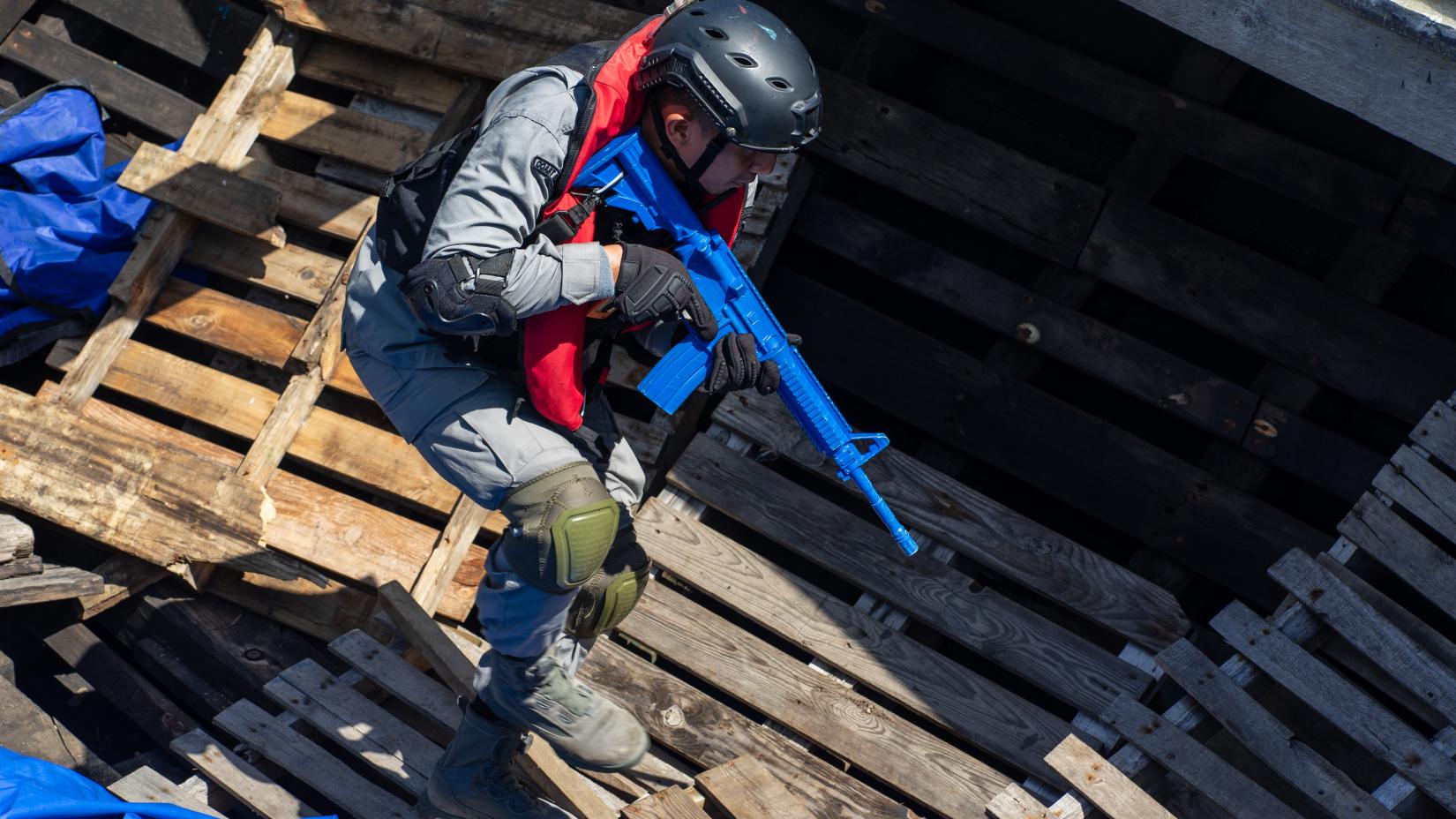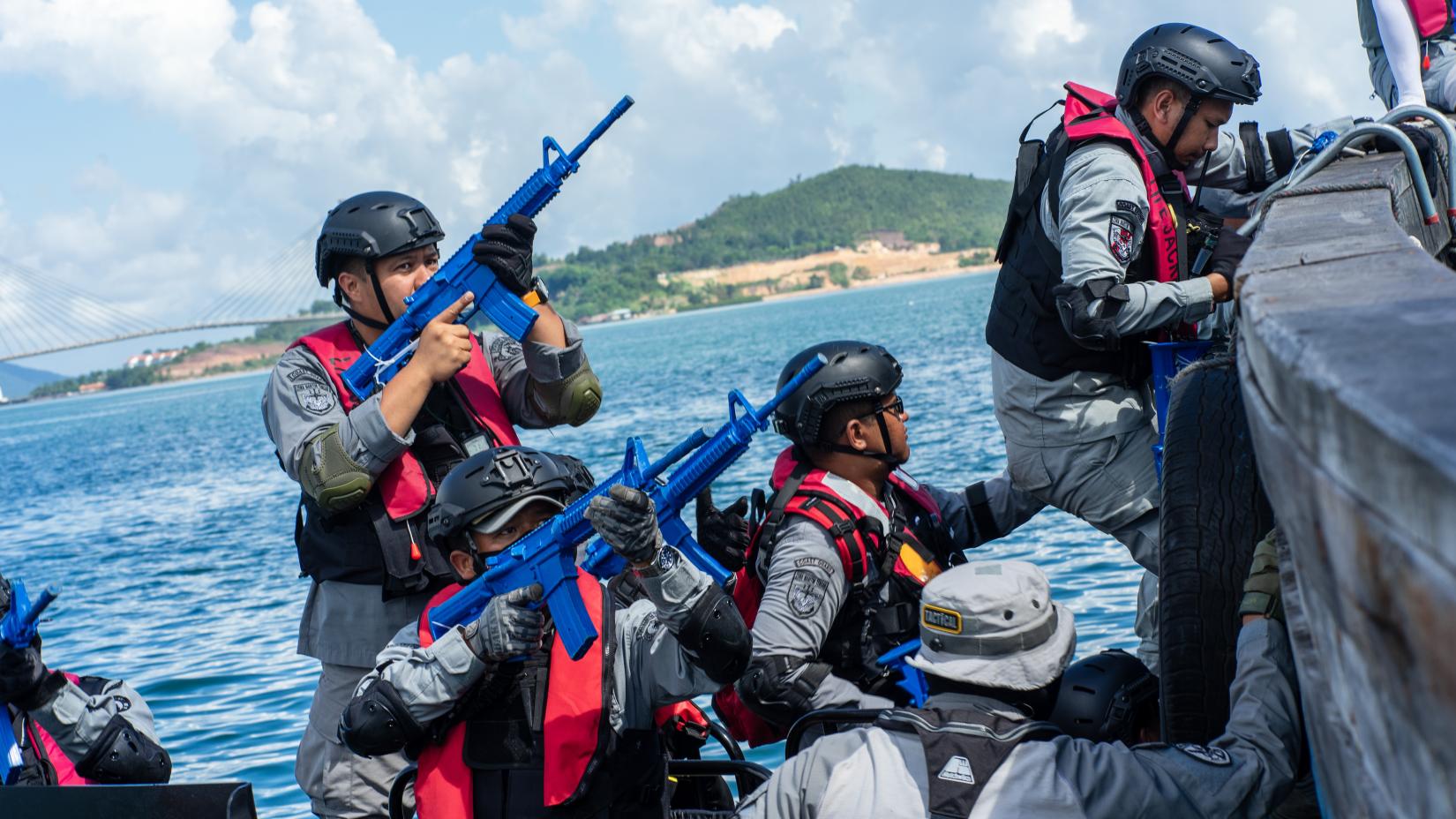Indonesia Is Becoming a Center of Excellence in the Fight Against Maritime Crime
--

As the Indonesian Coast Guard’s dinghy buzzed the fishing vessel’s starboard side, sea spray arced from the green glassy waters of the Singapore Strait. When the speedboat circled back to port, the team of fatigue-clad women and men onboard aimed their rifles across the fishing boat’s bow and shouted commands to her crew. One incongruous detail: instead of carbon steel, the rifles they pointed were made of bright blue plastic.
Live at-sea drills like this are a key component of preparing maritime law enforcement agencies to prevent human trafficking, guard against illegal fishing, and intercept smuggled drugs, weapons, and wildlife. Such drills are now possible thanks to a Visit, Board, Search, and Seizure training facility established with UNODC support in early 2022 in collaboration with Indonesia’s Coast Guard (BAKAMLA). The center, in the coastal city of Batam, has enhanced the skills of more 100 officers from BAKAMLA, to date, alongside scores of agents from Malaysia’s Maritime Enforcement Agency (MMEA), the Philippine Coast Guard (PCG), and Viet Nam’s Customs Office.
Tony Wheatley, a maritime crime expert retained by UNODC who has led several courses at the center since its establishment, says the facility has enabled him to take training beyond the classroom and simulate the practical challenges law enforcement officers encounter in the line of duty. The difference he sees in officers’ skill levels after they complete the training “is night and day,” said Wheatley at the end of a recent course for 24 Indonesian, Malaysian and Viet Namese trainees, “they can now board a vessel effectively, they can communicate, secure and search the vessel effectively, and they can also collect evidence effectively.”
Those capabilities are in acute demand in the Strait of Malacca, the shipping superhighway that runs between the littoral states of Singapore, Malaysia, and Indonesia. Each year, around 90,000 ships pass through the Malacca and Singapore Straits, whose torpid waters stretch from the westernmost corner of Malaysia, narrowing to just three kilometers before reaching the tip of Indonesia’s Bintan Island. The Strait links the economies of India, China, and Japan, and connects the Indian Ocean with the Pacific.
A UNODC report published in June 2023 says that drug traffickers in Southeast Asia are increasingly using the sea to avoid interception by law enforcement agents carried out in Thailand and China, a trend that has continued since the COVID-19 pandemic when many land borders were closed.
Smugglers are moving significant supplies of methamphetamine and other illegal drugs through central Myanmar to the Andaman Sea because less attention is paid to monitoring the waters, the report says, with drug cartels having been more successful in expanding production and smuggling routes in 2022 compared with the previous year. That, combined with tactical innovations—such as a proliferation of the use of UAV spotters to evade law enforcement patrols—makes maritime crime ever harder to police.
Both bilateral and multi-lateral policing efforts are necessary given the increasing sophistication of transnational crime, says Kenneth Zurcher, Director of International Narcotics and Law Enforcement Affairs at the U.S. Embassy in Jakarta, which supports the UNODC Programme. “Building the capacity and partnerships between the different coastguards and law enforcement agencies is very important—they’re going to have to work together as they address these activities.”
At least as early as the 14th Century, when traveller Wang Dayuan chronicled marauding attacks pirates launched on laden ships returning from China, the Malacca Strait has been associated with piracy. Although multinational naval efforts have led to a decline in piracy and kidnap-for-ransom since 2016, authorities reported 25 incidents of armed robbery against ships in the first three months of 2023—a 9 percent rise year-on-year. Meanwhile, the same coves and jungled islets that enabled generations of pirates to evade capture continue to provide a haven for smugglers and traffickers today.
“When it comes to countering criminal activity at sea, the primary agencies are the Coast Guard agencies,” says Shanaka Jayasekara, who oversees UNODC’s Maritime Crime Programme in Southeast Asia and the Pacific. Sharing knowledge and best practices between littoral nations helps ensure those agencies are able to operate effectively, he adds: “The Coast Guard sector is very much a young sector in Southeast Asia, and the UN is creating the connections and relationships amongst coast guard agencies.”
UNODC recently purchased an underwater remotely operated vehicle that will help trainees at the Batam facility practice searching for drugs concealed under ship’s hulls. The center also runs specialist training on night boarding, detecting chemical, biological, radioactive, and nuclear material—including transfers that take place in breach of UN Security Council sanctions against North Korea—and protecting migrants, and women and children on board non-compliant vessels.
As the June sun sunk into the Singapore Strait on the penultimate day of a Batam training course, BAKAMLA officers stalked the bow of a wooden shipping vessel to identify hazards and assess its seaworthiness. On deck, three officers conducted a body search of an armed crew member and secured evidence in Ziplock bags, while others tied a tourniquet around the leg of a teammate simulating an injury.
Learning international standards for safely boarding and searching suspicious vessels, and bonding with counterparts from Malaysia and Vietnam, said one of the BAKAMLA officers, who requested not to be named, would assist him with his job of guarding Indonesia’s coast. “I want to protect my sea environment,” he said, “Because it is the sea that gives us life.”



Joseph Hincks/Batam, Riau Islands


